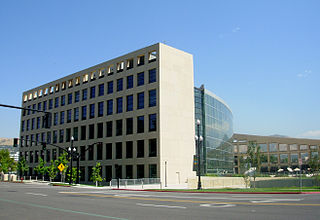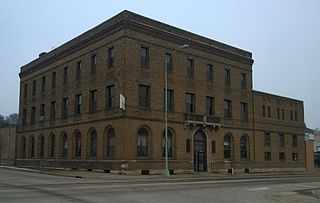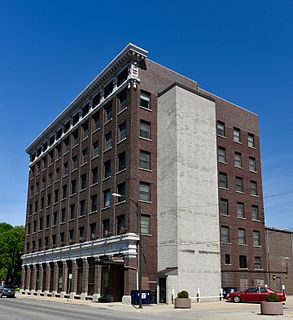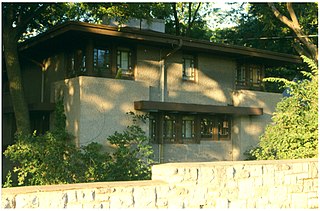
Mason City is a city and the county seat of Cerro Gordo County, Iowa, United States. The population was 27,338 in the 2020 census, a decline from 29,172 in the 2000 census. The Mason City Micropolitan Statistical Area includes all of Cerro Gordo and Worth counties. It is commonly referred to as the "River City", as the city grew up centered on the Winnebago River.

The Harlem YMCA is located at 180 West 135th Street between Lenox Avenue and Adam Clayton Powell Jr. Boulevard in the Harlem neighborhood of Manhattan, New York City. Built in 1931-32, the red-brown brick building with neo-Georgian details was designed by the Architectural Bureau of the National Council of the YMCA, with James C. Mackenzie Jr. as the architect in charge. It replaced the building from 1919 across the street. Inside the building is a mural by Aaron Douglas titled "Evolution of Negro Dance." The building was declared a National Historic Landmark in 1976, and was designated a New York City Landmark in 1998.

The former First Church of Christ, Scientist, located at 23 3rd Street, N.W. in Mason City, Iowa, is an historic structure that was added to the National Register of Historic Places in 1997, and as a contributing property in the Mason City Downtown Historic District in 2005. It was designed by Minneapolis architect Clyde W. Smith and was deemed significant as a notable example of 1920s architectural eclecticism. It includes elements of Romanesque and Gothic Revival styles. Further, according to its NRHP nomination: "The design of the building reflects the propensity of Christian Scientists to break with traditional church planning and design. The building features no symbols, icons or other typical religious ornamentation that would be representative of a religious hall. Instead it reflects an 'advance design' exhibited in the highest quality construction techniques and standards of the era."

The Salt Lake City Public Library system is a network of public libraries funded by Salt Lake City. The Free Public Library of Salt Lake City first opened on February 14, 1898. The system is under the direction of a library board and circulates more than three million items each year.

There are 70 properties listed on the National Register of Historic Places in Albany, New York, United States. Six are additionally designated as National Historic Landmarks (NHLs), the most of any city in the state after New York City. Another 14 are historic districts, for which 20 of the listings are also contributing properties. Two properties, both buildings, that had been listed in the past but have since been demolished have been delisted; one building that is also no longer extant remains listed.

The Medina Armory is located on Pearl Street in Medina, New York, United States. It is a large stone building constructed at the beginning of the 20th century.

Greenwich YMCA is a historic building at 50 East Putnam Avenue in Greenwich, Connecticut. Built in 1916 as a gift from Mrs. Nathaniel Witherill, it is a distinctive example of Colonial Revival / Georgian Revival style with Beaux Arts flourishes. The building was listed on the U.S. National Register of Historic Places in 1996.

Ottumwa Young Women's Christian Association , also known as Your Family Center, is a historic building located in Ottumwa, Iowa, United States. Its significance is related to the local social movement that provided a safe place to live for young women and education programs that encouraged their business and professional development. The Young Women's Christian Association (YWCA) was established in Ottumwa in 1894 by 64 charter members. They began with opening reading and rest rooms before they opened a boarding house. In 1903 they acquired the former First Baptist Church building for their use. They cooperated with the local Young Men's Christian Association (YMCA) for recreational and camping activities. The YMCA built a new larger facility in 1921 and the YWCA considered buying their old building, but they decided to build their own building instead.

The MBA Building, or Modern Brotherhood of America Building, also known as the Brick and Tile Building, is a large office building in Mason City, Iowa, built in 1916-1917 for the Modern Brotherhood of America, a fraternal lodge. The MBA's primary purpose was to provide life insurance to its members, and the building housed those operations.

The Kirk is a historic building located in Mason City, Iowa, United States. Completed in 1903, this was the city's first luxury apartment building. Horace P Kirk, who owned and managed the building, was a Mason City businessman, photographer, and civic leader. He built two other buildings here and to the north that were destroyed in a fire in 1902. This building was built on the site of Kirkland Flats, and parts of its stone foundation and north wall may be from the H.P. Kirk wholesale building that had been built in 1892. Originally The Kirk supplied heat, light, and water for the apartments with its own steam generating plant. It has subsequently acquired city utilities. The building features an eclectic design that is organized into horizontal and vertical elements. The horizontal is realized in wide brick bands on the floors. The vertical is realized in the copper-clad oriel windows that tie the second and third floors to the cornice. The building was individually listed on the National Register of Historic Places in 1982, and as a contributing property in the Mason City Downtown Historic District in 2005.

Hotel Lester-Lester Cafe, also known as the Dodge House-Long Branch, is a historic building located in Mason City, Iowa, United States. Its construction, completed in 1915, was a project undertaken by local real estate developer Meir Wolf. It was built as a two-story building a block away from the passenger and freight depots of the Chicago and North Western Railroad and the Chicago Great Western Railway. The building was meant to be used as a railroad hotel so passengers and rail employees would not have to travel the six to eight blocks to the hotels downtown. It is the only remaining railroad hotel left in Mason City. Hotel guests stayed in the 29 rooms on the second floor, and three commercial spaces on the first floor were occupied by a variety of restaurants, grocery stores and barbershops. Its most famous guest was track star Jesse Owens, who was in town in December 1937 for a basketball exhibition. He could not stay at the other hotel's in town because of his race. In 1975 the hotel's name was changed to the Dodge House and the Long Branch Saloon occupied the space that had previously housed a cafe. By that time it was largely used as a rooming house, and it was used to house the homeless. The building was listed on the National Register of Historic Places in 2002.

The Mason City Public Library is located in Mason City, Iowa, United States. The building that was funded by Andrew Carnegie, and is now an office building, was listed on the National Register of Historic Places in 1989. It was included as a contributing property in the Mason City Downtown Historic District in 2005.

The First National Bank of Mason City, also known as Norwest Bank Building and City Center of Mason City, is a historic building located in Mason City, Iowa, United States. It was designed by the Des Moines architectural firm of Liebbe, Nourse & Rasmussen, and it was the only Mason City commission for this firm. Completed in 1911, it was constructed by C.E. Atkinson of Webster City, Iowa who had built several other H.F. Liebbe designs. The 6½-story building follows the Early Commercial style. It features modestly decorated main floor and attic level with five floors of rather plain brick construction in between. The bank occupied most of the first floor and some of the office space above, while the other office space was taken up by professional offices. By the 1960s the bank occupied the whole building. John Dillinger, Baby Face Nelson, John Hamilton and Tommy Carroll robbed the bank on March 13,1934 and stole about $50,000. Dillinger was wounded in an exchange of gunfire during the heist. The building to the north of the bank was torn down in 1982 and a two-story annex to the bank replaced it. The bank building was individually listed on the National Register of Historic Places in 1997, and as a contributing property in the Mason City Downtown Historic District in 2005. City Center of Mason City Inc. bought the building in 1995, and remodeled it into apartments and offices.

Parker's Opera House, also known as Opera House Store, Woolworth's and Parker Place, is a historic building located in Mason City, Iowa, United States. It was designed by the prominent Des Moines architect William Foster. Cousins H.G. and A.T. Parker built this structure as an opera house, which was the first one in the community. While it initially filled a need in Mason City, it was replaced by more modern theatres around the turn of the 20th century. The third floor was created in the building in 1909 when it was placed across the middle of the auditorium. The first floor initially housed a clothing store, and F. W. Woolworth Company occupied it beginning in the mid-1920s, and the upper floors housed the local offices of the Standard Oil Company at the same time. The two-story addition in the rear was built in the 1960s. The first floor was redesigned in 1997 for Central Park Dentistry. The upper floors were converted into apartments in 2013.

The Mason City Downtown Historic District is a nationally recognized historic district located in Mason City, Iowa, United States. It was listed on the National Register of Historic Places in 2005. At the time of its nomination it contained 93 resources, which included 63 contributing buildings, one contributing site, four objects, 22 non-contributing buildings, and three non-contributing objects. Platted in 1855, Mason City is a commercial and industrial center for north central Iowa. It was also a railroad center, but the tracks bypassed the central business district in order to serve the industries located on the north side of town and the wholesale enterprises on the south side. Central Park, a public square, was part of the city's original plat and is the contributing site.

The Rock Crest–Rock Glen Historic District is a nationally recognized historic district located in Mason City, Iowa, United States. It was listed on the National Register of Historic Places in 1979. At the time of its nomination it contained 10 resources, which included eight contributing buildings, one contributing site, and one non-contributing building. All of the buildings are houses designed in the Prairie School style, and are a part of a planned development. Joshua Melson, a local developer, bought the property along Willow Creek between 1902 and 1908. Initially, there were only going to be 10 houses built, but the number grew to 16. While only half the houses planned were actually constructed, it is still the largest cluster of Prairie School houses in the country. The one non-contributing house is the 1959 McNider House, a Modern movement structure that was built where one of the planned houses was to be built, but never was. The architects who contributed to the district include Walter Burley Griffin, who provided the initial plan for the development; Barry Byrne, who took over from Griffin; Marion Mahony Griffin, Walter Griffin's wife and an architect in her own right; and Einar Broaten. Frank Lloyd Wright had a design that was never built here. The plans were used to build the Isabel Roberts House in River Forest, Illinois instead.

The Boerner-Fry Company/Davis Hotel is a historic building located in Iowa City, Iowa, United States. Emil Louis Boerner was born in Prussia and came to Iowa City with his family when he was 12. He was educated at the Philadelphia College of Pharmacy, and he owned and operated a drugstore in Iowa City for 57 years. He was also one of the primary organizers of the Iowa Pharmaceutical Association, a member of the faculty at the newly established Iowa College of Pharmacy in Des Moines, and was involved in establishing the Department of Pharmacy at the University of Iowa where he served as its first dean. Boerner and his partner William A. Fry had this building constructed in 1899 as a factory that produced toilet articles and light pharmaceuticals. Local contractor Jacob J. Hotz was responsible for its construction. The factory relocated to another facility in 1915, and went out of business the following year. This building was used for a variety of businesses until 1922 when it was converted into the Washington Hotel. George W. Davis renamed the hotel after himself in 1952, and he continued to operate it until 1972. It was then converted into office and retail space. The building was individually listed on the National Register of Historic Places in 1983. In 2021, it was included as a contributing property in the Iowa City Downtown Historic District.

Franklin Printing House, also known as the Koza Building, is a historic building located in Iowa City, Iowa, United States. It was built in 1856 expressly for the purposes of housing the Iowa Capitol Reporter, a local newspaper named for when this was Iowa's capital city. The newspaper's offices were located on the main floor, the composition room was on the second floor, and printing press was in the basement. The Iowa Capitol Reporter was sold by the 1860s and the Iowa City Republican took over the building. They moved out in the mid-1870s, and the building housed a series of saloons into the 1890s. After it was occupied by a variety of businesses, the building housed John V. Koza's meat shop for about 40 years. The three-story brick building is considered an excellent example of pre-Civil War commercial architecture in Iowa City. The metal cornice across the top of the main facade dates from some time prior to 1904. The present storefront dates to a 1984 renovation, at which time the two cast iron columns were discovered. The building was individually listed on the National Register of Historic Places in 1986. In 2021, it was included as a contributing property in the Iowa City Downtown Historic District.





















